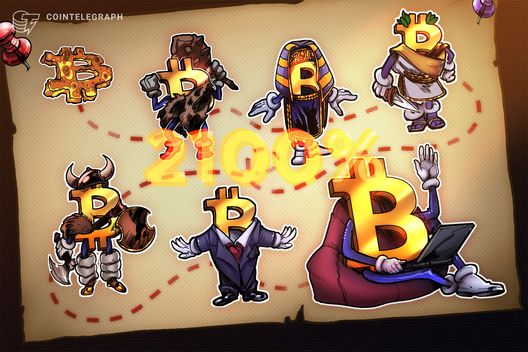
Der jüngste Block-Aktienkauf von ARK Invest ist der erste seit Monaten und deutet auf eine mögliche Änderung der Anlagestrategie des Unternehmens hin.

Finanzmittel Info + Krypto + Geld + Gold
Krypto minen, NFT minten, Gold schürfen und Geld drucken

Der jüngste Block-Aktienkauf von ARK Invest ist der erste seit Monaten und deutet auf eine mögliche Änderung der Anlagestrategie des Unternehmens hin.
Cryptocurrencies display recovery signals after July’s CPI inflation of 2.7% boosts sentiments in risky assets.
Ethereum has crossed $4,400, renewing altseason conversations.
Meanwhile, this article highlights ongoing developments in meme cryptocurrencies, focusing on Bonk, Shiba Inu’s ecosystem, and FARTCOIN.
On Monday, Healthy beverage firm Safety Shot Inc. received BONK tokens worth around $25 million as part of its crypto treasury initiative.
The Nasdaq-listed company plans to accumulate 5% of Bonk’s token supply, worth $115 million at the current market price, by year-end.
🚨 CMC News: $BONK Treasury Safety Shot Targets $115 Million Acquisition by Year-End.
🔗 https://t.co/jwgDmuR6ay pic.twitter.com/1fCnhVeaEI
— CoinMarketCap (@CoinMarketCap) August 12, 2025
Safety Shot will hold approximately $25 million worth of BONK assets and has become the first Nasdaq firm to establish a treasury dedicated to the meme token.
The wellness company’s move follows similar models by traditional entities establishing crypto treasuries and prioritizing lesser-known altcoins.
Recently, Heritage Distilling adopted the Story Protocol ($IP) as a reserve token.
Moreover, SharpLink is in an Ethereum accumulation spree.
BONK trades at $0.00002484 after dropping over 6% of its value in the previous 24 hours.
Safety Shot’s significant bet suggests confidence in BONK’s future performance.
The latest LEASH supply adjustments have raised centralization concerns within the Shiba Inu ecosystem.
Notably, LEASHE supply saw a dramatic increase on August 11, with 10,765 new coins created.
The move grabbed attention as community members trusted that the project had a fixed supply.
Furthermore, the project had claimed to have disabled rebasing to cancel automatic token supply adjustments via code.
Shiba Inu’s lead developer, Kaal Dhairya, clarified the sudden and controversial 10% surge in LEASH supply.
The dev confirmed that the team discovered a rebase pathway still existing in LEASH smart contracts.
It was linked to pre-authorized contracts that enabled adjustments without owner mediation.
According to Dhairya, this incident breaches trust as the community believed in an unchangeable token supply.
He concluded:
Dealing with a chaotic system with multiple owners and inherited, deceptive structures has been exhausting for me to keep aligned and safe for the community. I’m committed to transparency and putting these decisions in the hands of the DAO.
LEASH has declined by nearly 30% in the past 24 hours to $118, with a 75% trading volume uptick signaling intensified activity possibly from sellers.
Fartcoin struggled with bearish tendencies after losing the $1 mark during the weekend.
It trades at $0.8760 after losing nearly 12% over the past 24 hours.

Pump.fun’s dwindling momentum contributes to FARTCOIN’s bearish sentiments.
The meme Launchpad unveiled the Glass Foundation last week to stabilize Solana-based tokens.
However, Pump.fun’s daily revenue continued to decline, suggesting a waning interest in Solana meme tokens.
Rivals like LetsBonk.fun are stealing the show, outshining PUMP’s platform in token launches.
Bearish technical indicators suggest further declines for FARTCOIN before possible comebacks.
The post Meme coin news: BONK’s $115M deal, LEASH supply twist, FARTCOIN plunges appeared first on CoinJournal.

Kurzfristige Ether-Inhaber verstärken ihre Gewinnmitnahmen, da der Kurs von ETH im letzten Monat um 43 % gestiegen ist.

Ein Analyst prognostiziert, dass Bitcoin in diesem Zyklus 340.000 US-Dollar erreicht, wenn der Zuwachs so groß ausfällt wie bei den letzten Zyklen.
Circle, the issuer of the USDC stablecoin, has announced the launch of its own layer-1 blockchain, Arc, even as it posted strong revenue growth alongside a hefty quarterly loss.
The move marks a major step in the company’s ambition to become a full-stack platform for digital finance, while also highlighting the financial challenges of its first earnings report since going public.
In its second-quarter 2025 results released Tuesday, Circle reported a 53% year-over-year increase in total revenue and reserve income, reaching $658 million.
The revenue growth was fueled by a surge in USDC adoption, expanding subscription service revenues, and increased activity across decentralised finance platforms.
Despite the revenue jump, Circle posted a $482 million net loss for the quarter.
The company attributed this to one-time, non-cash expenses linked to its blockbuster IPO earlier this year, including $424 million in stock-based compensation and a $167 million revaluation of convertible debt.
Adjusted EBITDA rose 52% to $126 million, showing operational strength despite the headline loss.
The company’s newly announced Arc blockchain will be compatible with the Ethereum Virtual Machine (EVM) and use USDC as its native gas token.
This means users will be able to pay transaction fees directly with the stablecoin, a move aimed at streamlining on-chain payments and lowering friction for institutional and retail users.
Arc is designed for high-performance financial applications, with sub-second settlement, an integrated stablecoin foreign exchange engine, and opt-in privacy controls.
Circle says the network will be fully integrated into its existing platform while remaining interoperable with the 24 other partner blockchains where USDC already operates.
USDC’s market capitalisation stood at $65.6 billion at the time of the announcement, with $42.6 billion of that supply on Ethereum, according to a recent report by Circle.
Circle has revealed that USDC circulation grew 90% year-over-year to $61.3 billion by the end of Q2 and has since climbed further to $65.2 billion as of August 10.
We just reported our Q2 2025 earnings, our first as a publicly traded company.
USDC in circulation reached $61.3B at the end of Q2, up 90% YoY, with $5.9T in onchain volume during Q2.
Read the results here: https://t.co/a6fwiWoTNK pic.twitter.com/lgTOOTIEAq
— Circle (@circle) August 12, 2025
Adding to this momentum, Whale Alert recently flagged a $250 million USDC mint at the USDC Treasury.
Such large-scale issuance often points to increasing demand from both institutions and retail investors, injecting liquidity into exchanges and DeFi protocols.
This influx of capital can serve as a catalyst for trading activity and broader market growth.
By launching Arc, Circle is positioning itself to capture more of the stablecoin-powered payments and capital markets segment.
The combination of its growing USDC supply and an in-house blockchain tailored for financial use cases could strengthen its influence in the global digital asset ecosystem.
The expansion also underscores Circle’s long-term bet that stablecoins will become a backbone of international finance.
With clear regulatory momentum in key jurisdictions and growing adoption of digital dollars, the company is seeking to leverage its brand trust and market presence into a deeper role in global transactions.
However, the sizable Q2 loss serves as a reminder of the costs of scaling in a competitive and highly regulated industry.
As Arc heads toward public testnet later this year, traders and institutions will be watching closely to see whether Circle can turn its strong revenue growth into sustained profitability, while cementing USDC’s position at the heart of digital finance.
The post Circle unveils Arc Blockchain amid 53% revenue surge, $482M Q2 loss appeared first on CoinJournal.